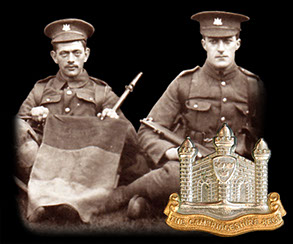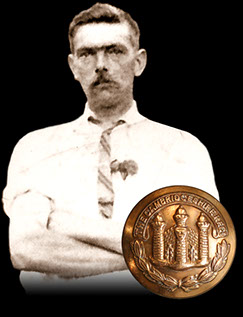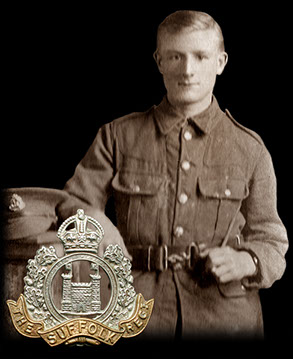
Who Were
The Cambs
The Cambs
at War
1/1st Btn 1914-1919
1914 - 1/1st Overview
1915 - 1/1st Overview
1915 - St Eloi
1915 - Fosse Wood
1916 - 1/1st Overview
1916 - The Schwaben
1916 - St Pierre Divion
1917 - 1/1st Overview
1917 - St Julien
Insignia, Medals & Books
Remembering The Cambs
Biographies
About Us &
This Site
Replacing The Casualties – The Cambridgeshire Regiment's Replacement Drafts
Families tracing relatives who served in World War One often find their ancestors trained with one regiment but saw front line action in another unrelated unit. This certainly happened to some men who trained with the Cambridgeshires.
Casualties suffered by the 1/1st Cambridgeshire Regiment on the Western Front required reinforcements to bring it up to strength. This involved drafts being sent from the UK to Base Camps on the French coast, where further training was given before the men were forwarded to the front line.
As they were formed, the three home service battalions of the Cambridgeshire Regiment, named 2/1st, 3/1st and 4/1st, eventually began to send reinforcements to 1/1st Btn on the Western Front.
Having gone to the Western Front in February 1915, the 1/1st Btn were soon sustaining casualties and their first major reinforcement, four officers and 100 men of 2/1st Btn, sailed on July 10 from Southampton to Le Harve. The 3/1st Btn, formed in February 1915, sent its first draft, 100 men, travelling from Southampton to Rouen on September 29. Men who had recovered from earlier wounds were often included in these drafts.
Batches of reinforcements, both officers and other ranks, were sent for the remainder of the year and into the summer of 1916, all finding their way to 1/1st Btn. However, the certainty of such replacements joining their parent regiment ended with the start of the Somme offensive on July 1, 1916.
Such were the massive casualties that men who had enlisted to serve in the Cambridgeshires could find themselves arriving in France with the expectation of joining their colleagues, only to have those hopes dashed as they were directed to where replacements were urgently needed. Sometimes they would end up in battalions serving alongside the 1/1st Btn in 39th Division, but not always – the complete list of regiments they joined is too numerous to mention here.
For instance, a large draft from the Cambridgeshires left Folkestone on July 16 and trained at the notorious Bull Ring at Etaples, before eventually joining the 6th Royal Berkshires on September 9. It should be noted that men of the home service battalions were also being transferred to home service battalions of other regiments, such as the Yorkshire Regiment and Northumberland Fusiliers, and eventually sent overseas.
Figures show that by August 5 1916, the Cambridgeshires’ home service battalions had supplied 60 officers and 765 men since 1915.
Another example would be the 170 men that left England on August 17, destined for 1/1st Btn but eventually joined 12th and 13th Royal Sussex (39th Division) in early September. However, some men meant for the Cambridgeshire were still getting to their colleagues in 1/1st Btn.
Again, a 3/1st Btn draft sent in September for 1/1st Btn was posted to the Norfolk Regiment. Similarly another batch of 120 men from 3/1st ended up in the 11th and 12th King’s Royal Rifles (also 39th Division), while in October a draft of Cambs Regt men found themselves in 2nd Lincolnshires. As the Somme campaign drew to a close in November 1916, the Cambridgeshires’ major overseas drafts were once again going almost exclusively to its 1/1st Btn.
Early in 1917, the reinforcements continued to fill gaps left by casualties in the 1/1st Btn, now in the Ypres Salient, but a few groups were posted elsewhere, such as to the Middlesex Regiment and, once again, the Northumberland Fusiliers. As the 4/1st Cambs was disbanded in the summer, some men were dispersed to other home service battalions, as well as overseas to 11th Royal West Kent Regt and 150 going 1/6th Gloucestershire Regt.
The 3/1st Cambs had amalgamated with a reserve battalion of the Suffolk Regt to form the Cambs & Suffolk Reserve Btn, The Suffolk Regt. It supplied reinforcements to both the Cambridgeshire Regt and Suffolk Regt. Some Cambridgeshires posted to the Suffolks would find themselves back with 1/1st Cambs in May 1918 when the 7th Suffolks were disbanded. The 7th Btn had itself received reinforcements from its Regiment’s previously disbanded 9th and 8th Battalions, which had both received Cambs Regt men.
Of course, it wasn’t all one-way traffic because the 1/1st Btn also gained reinforcements from other regiments from late 1916 and the remainder of the war. Further information about how these drafts changed the composition of the 1/1st Btn can be found by clicking here.
It is also known that a draft of Cambs Regt men ended up in the 15th Notts & Derby Regt in February 1918.
The disbandment of 2/1st Cambs in early 1918 coincided with several drafts of their men reaching 1/1st Btn by May 1918, along with four drafts from the Cambs & Suffolk Reserve Btn, which continued to supply it with reinforcements for the remainder of the war, although some still found their way elsewhere, such as the 17th Essex in June 1918.
The Cambs & Suffolk Reserve Btn supplied many drafts to 1/1st Battalion during July and August 1918, particularly as the Allies launched their final and what would prove decisive offensive. However, they couldn’t keep up with losses, and, at the end of August, two large drafts of Leicestershire Regiment men found themselves posted to 1/1st Cambs.
Regular, but smaller drafts continued up to and after the Armistice on November 11, 1918, while in early 1919 as men were demobbed, the 1/1st Btn sent two officers and 140 other ranks to join the 11th (Cambridgeshire) Btn, Suffolk Regt, which would be part of the Army of Occupation in Germany. Finally in May 1919 the remaining cadre of the 1/1st Cambridgeshires made its way to England. The war was over for the Cambridgeshires.

Men from a 1915 replacement draft.

Hugh Allen was part of a draft that ended up in the 6th Royal Berkshire Regiment, he was killed on October 17th 1916.

John Edwards, a pre-war member of the Benwick Chickens, was part of a draft that found themselves posted to the 9th Norfolks on the Somme in 1916.

Frank Smith was in a draft from the Cambs & Suffolk Reserve Btn heading to the 1/1st Cambs in 1918 but ended up in the 1st Lincs Regt instead.

This site went live on the 14th February 2015 to mark 100 years since the 1/1st Cambs went off to war.
WE WILL REMEMBER THEM
Email us: cambsregt@gmail.com
Copyright 2015, 2016, 2017, 2018, 2019 by Felix Jackson. The information and images on this site should not be reproduced without prior permission.